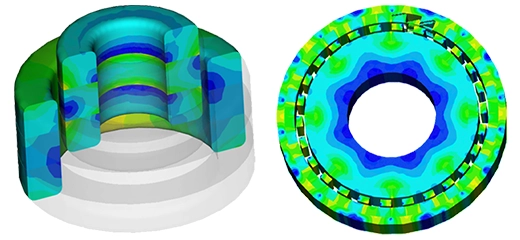Introduction
A magnetic gear is a type of gear system that uses magnetic forces to transmit torque between two rotating components without physical contact. It is an alternative to traditional mechanical gears that rely on teeth meshing to transfer power. The operation of a magnetic gear relies on the principles of magnetic attraction and repulsion. The input component's magnetic field interacts with the magnetic field of the output component, resulting in torque transfer. The gear ratio can be adjusted by changing the configuration and arrangement of the magnets.
The benefits of Magnetic Gears
Magnetic gears offer several important advantages and benefits, making them significant in various applications:
Efficiency: Magnetic gears can achieve high efficiency due to their non-contact nature. They eliminate mechanical losses associated with friction and wear, resulting in improved power transmission efficiency.
Durability and Reliability: Magnetic gears have a longer operational life compared to traditional mechanical gears. The absence of physical contact reduces wear and tear, leading to increased durability and reliability.
Noise Reduction: Magnetic gears operate silently since they do not have physical contact between components. This characteristic makes them ideal for noise-sensitive environments or applications where quiet operation is desired.
Torque Overload Protection: Magnetic gears can provide inherent torque overload protection. When the torque exceeds a certain threshold, the magnetic forces can disengage, preventing damage to the system. This feature is crucial for safety and protecting equipment from excessive loads.
Design Flexibility: Magnetic gears offer greater design flexibility compared to traditional gears. The gear ratio can be easily adjusted by changing the configuration and arrangement of the magnets. This adaptability allows for customization to meet specific application requirements.
EMWorks Solution for Magnetic Gear Technology
Magnetic gear simulation is crucial for the design, optimization, and analysis of magnetic gear systems. It allows engineers to validate and optimize designs, predict performance characteristics, assess efficiency, ensure structural integrity, optimize costs, and support research and development. EMWorks offers a full simulation solution specifically designed for magnetic gears. It enables engineers to analyze magnetic field distribution, optimize gear designs, evaluate efficiency, and perform thermal and structural analysis in order to validate magnetic gearing designs. The solution integrates seamlessly with popular CAD software and provides a user-friendly interface.
The axisymmetric invariance property of the following Coaxial Magnetic Gear, shown in Figure 1, allows both 2D and 3D simulations using EMWorks DC Magnetic analysis with coupling to motion. The simulation reveals the following results including magnetic vector potential, Magnetic flux density B, and torque curves:



